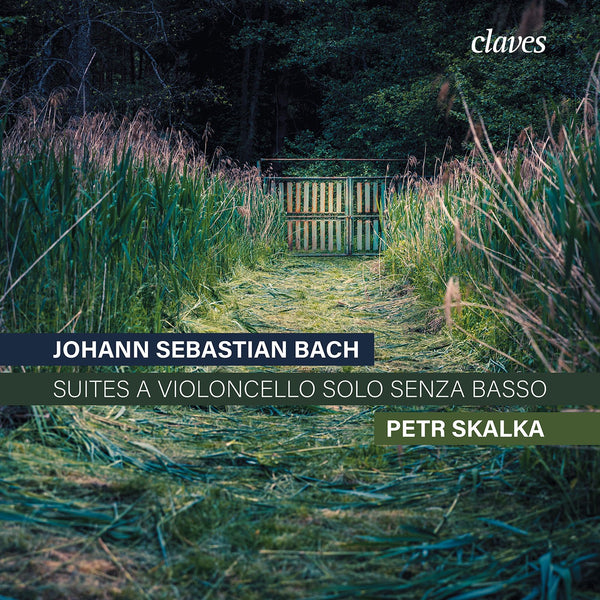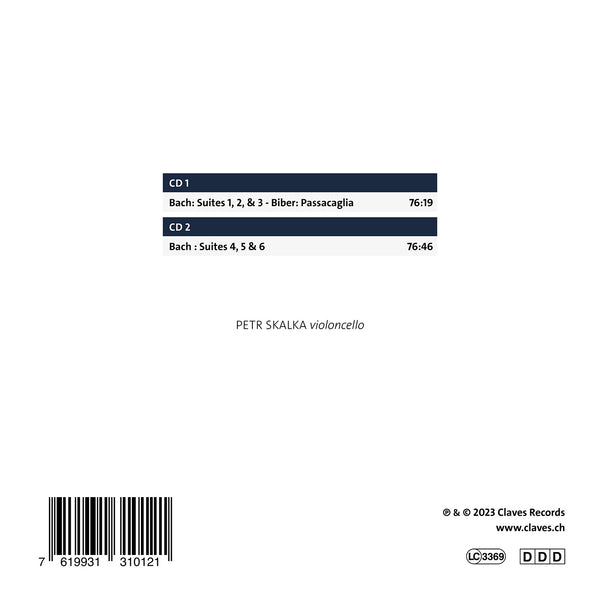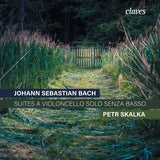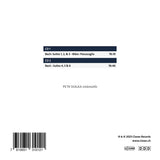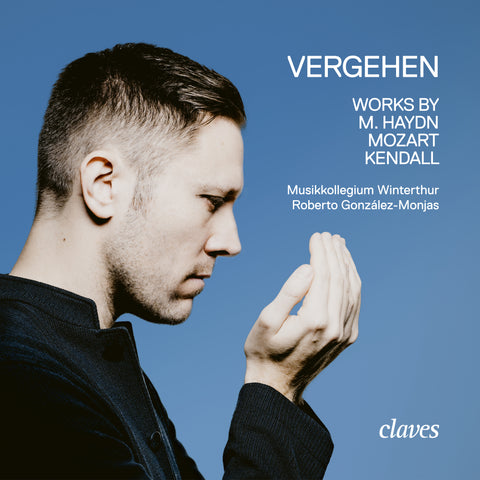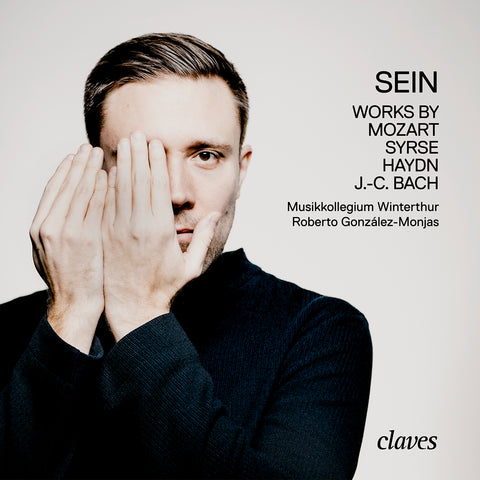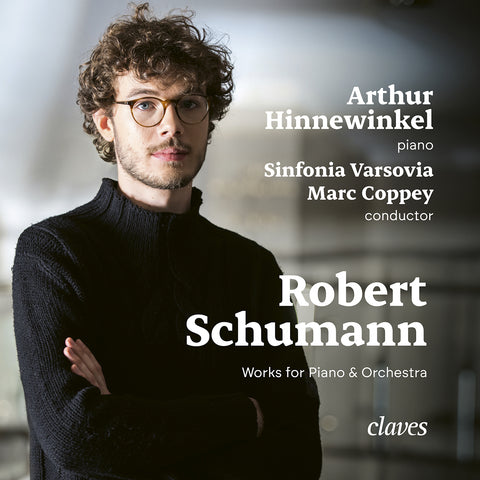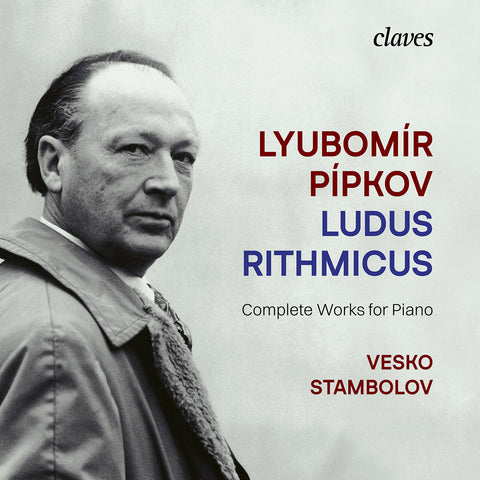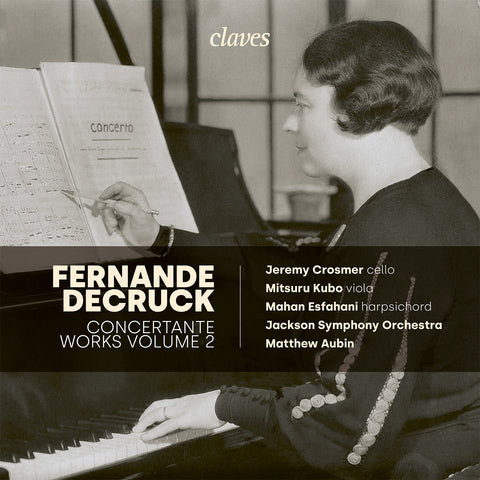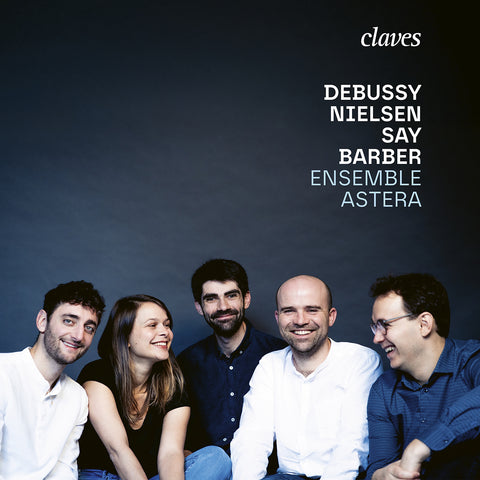(2024) 6 Suites a Violoncello solo senza Basso
Category(ies): Chamber Repertoire
Instrument(s): Cello
Main Composer: Johann Sebastian Bach
CD set: 2
Catalog N°:
CD 3101/02
Release: 09.02.2024
EAN/UPC: 7619931310121
This album is now on repressing. Pre-order it at a special price now.
CHF 24.00
This album is no longer available on CD.
This album has not been released yet. Pre-order it from now.
CHF 24.00
This album is no longer available on CD.
CHF 24.00
VAT included for Switzerland & UE
Free shipping
This album is no longer available on CD.
VAT included for Switzerland & UE
Free shipping
This album is now on repressing. Pre-order it at a special price now.
CHF 24.00
This album is no longer available on CD.
This album has not been released yet.
Pre-order it at a special price now.
CHF 24.00
This album is no longer available on CD.
CHF 24.00
This album is no longer available on CD.
6 SUITES A VIOLONCELLO SOLO SENZA BASSO
SOME PERSONAL REFLECTIONS ON J.S. BACH’S SUITES FOR VIOLONCELLO SOLO SENZA BASSO
With these words begins the first written cello method, authored by Michel Corrette and published in Paris around 1741: the cello, a bass instrument, is considered a “noble pillar of harmony”. At that time, music history was roughly in the middle of the basso continuo era, which began during Monteverdi’s lifetime with the “Seconda Pratica” and ended during Robert Schumann’s lifespan. A lot revolved around the melody of the bass line, its realisation and rendering. In Corelli’s orchestra, a large bass section comprising many instruments of different sizes, with several cellos, double basses, lutes and harpsichords, was placed just behind the concertino. Behind them were the intermediate voices, first and second violas. Only behind the latter were those who carried the melody of the upper voices, namely the violinists. Such a setting has nothing to do with today’s musical practice and sound expectations. The vast bass section determined the tempo, the character and the dynamics. Those providing the melody had to adapt; any resistance would have been pointless.
With this in mind, the title page of J. S. Bach’s Cello Suites may seem revolutionary at first glance: “6 Suites a Violoncello solo senza basso”. A musical work dedicated to an important instrument, the pillar of harmony, but “senza basso”, without bass! And this in an age in which there could be no music without bass, given the compositional method and practice of the basso continuo! In reality, the bass is clearly present in these solo suites. The designation “senza basso” is intended to warn the performer that there is no point in leafing through the pages of the score in search of the bass line. The bass is, in fact, already present in the monophonic solo part. [..]
THE CELLIST
“They (the Cello Suites) are the quintessence of Bach’s oeuvre, and Bach himself is the quintessence of all music.” P. Casals
The emotions of today’s cellist are the same as those of an 18th-century musician. But they are of a different intensity and are intertwined in another way. In today’s stressful world, we certainly feel the emotion of satisfaction or the nuances of love somewhat differently than a devout person in the Baroque era. The context of the concert is also completely different. Today, we play the Suites in bigger halls and to much larger audiences than in the past. However, these pieces remain the most intimate chamber music ever composed. One might say that they are intended only for the performer’s ears. Those who happen to be listening to the musician tend to watch from a distance in a somewhat voyeuristic manner. The cellist hears the Suites so close to the instrument that he can perceive the whispers of the rosin, the tension exerted by the pressure on the raw gut strings, the acoustic harmonics of the notes attacked more firmly. He can spatially discern the difference between the lowest and highest-pitched sounds as if they were coming from different directions. Conversely, an audience seated several metres away only perceives the sound of the cello from a specific point. [..]
THE MYSTERY OF NUMBERS
There are publications on the secrets of numbers in Bach’s music. Seeing this in a musical text can be exciting from an intellectual point of view. Some, for instance, see a hidden musical calendar in the Prelude to Suite No. 1 or look for the biblical name (D.A.VI.D., the note “F” (VI) as the sixth letter of the alphabet) in the Prelude to Suite No. 2. A practical-minded cellist is more fascinated by coincidences, such as the use of fingers in the Prelude in G major: first bar - one finger, second bar - two fingers, third bar - three fingers, fourth bar - but...
Another mysterious symbol is the use of the composer’s name as a sequence of notes: B-A-C-H (B flat-A-C-H in the German notation), perhaps his most intimate musical confession of the soul.
At first glance, given its complexity, it seems unlikely that such a sequence of notes would appear in a melody for a monophonic instrument, or maybe it is?
Petr Skalka
Translated from German by Michelle Bulloch - Musitext
PETR SKALKA
He grew up in a family of musicians in Marienbad (Czech Republic). His first encounter with music came from his father, who was himself a musician and cellist. After studying at the Pilsen Conservatoire, his interest in early music and historical performance practice led him to the highly respected Christoph Coin at the Schola Cantorum Basiliensis. Petr Skalka regularly performs with renowned chamber music ensembles throughout Europe (including Café Zimmermann, La Chambre Philharmonique, the Ensemble Baroque de Limoges, Christophe Coin, Gustav Leonhardt, and Emmanuel Krivine). He has taken part in numerous recordings, which have been honoured with several prestigious prizes (Diapason d’or, Classica’s Five Stars, etc.). Petr Skalka teaches at the Schola Cantorum Basiliensis in Switzerland.
REVIEWS
« En liminaire à la suite N.1, Petr Skalka propose un court Initio «improvisé» sur le parcours harmonique du premier Préude, avec des ornements des adagios de l'opus 5 de Corelli. Puis, entre les Suites N.3 et N.4, il intercale sa transcription de la Passacaille « de l’Ange gardien » extraite des Sonates du Rosaire de Biber. Le ton est donné: la démarche à la fois savante et ludique du Tchèque ne poursuit pas la quête d'une quelconque vérité absolue tant elle affiche une liberté expressive, une variété des climats et des notes d'agrément - dans leur richesse, pas leur multiplication - qui respectent toujours l'architecture des partitions et rejoignent en définitive l'esprit de la musique baroque. Sans recourir à une profondeur factice qui écraserait les accents, notamment dans les danses lentes où il privilégie une atmosphère songeuse. Ce disciple de Christophe Coin séduit par une articulation et une agogique à chaque fois imprévisibles qui installent une fraîcheur bienvenue. Fort bien épaulée par la captation précise du Giuseppe Guarneri « filius Andreae » de 1700, cette version au la à 415 Hz complète les meilleures réalisations plutôt qu'elle ne rivalise avec elles. » - Gérard Belvire, mai 2024
« Dans son texte de présentation, aussi musicologique que spirituel, Petr Skalka n'est pas le premier à faire ce constat à propos des Suites pour violoncelle : « Il semble impossible de fixer une interprétation définitive. Elle change de jour en jour. » Et son intégrale, d'une grande originalité, est tout sauf routinière : baroque, en un mot, par son parti pris d'irrégularité, par son goût pour les contrastes et les surprises, mais aussi par son élégance. Travaillée et pensée, cette version d'une parfaite cohérence n'en perd nullement en spontanéité: les coups d'arrêt dramatisent le discours, les préludes sont d'une folle liberté (celui de la Suite n° 6 est même véritablement halluciné), les danses rapides fusent, certaines tout à fait irrésistibles (Gigue de la Suite n° 1, Bourrée I de la Suite n° 3), et les pages lentes n'ont rien de pesant ou de sentencieux. Skalka a été à bonne école avec Christophe Coin, auquel il a d'ailleurs succédé comme professeur à la Schola Cantorum de Bâle. Il tire ici le meilleur parti d'un instrument de Guarneri (le « Filius Andreae ») monté en boyau et superbement capté. Quelques embardées de l'archet constituent un prix raisonnable à payer pour cette explosion de couleurs et d'idées. [..] » - Simon Corley, mars 2024
"Quizá el nombre del checo Petr Skalka no diga gran cosa al melómano. Nacido en Praga, estudió violonchelo en Pilsen y, posteriormente, en la Schola Cantorum Basiliensis, bajo la dirección de Christophe Coin, de quien fue discípulo predilecto. En la misma institución suiza ejerce actualmente como profesor asistente de su instrumento. Lo más seguro es que el lector le haya escuchado, tal vez de forma inadvertida, en alguno de los discos de Café Zimmermann, agrupación de la que fue chelista principal. Dicho esto, ¿tiene algo que ofrecer este músico de escaso renombre frente a una discografía repleta de referencias para todos los gustos? Pues sí: mucho y bueno. Para empezar, extrae un sonido de gran belleza, redondo, aterciopelado, lleno, denso y brillante, de los excelentes instrumentos empleados: un Guarnieri de ca. 1700 y, para el piccolo de cinco cuerdas, un instrumento construido por Dalibor Bzirský en 2018. Se trata, por otra parte, de una de las lecturas más comunicativas que yo haya escuchado: matiza permanentemente la partitura, introduce constantes detalles de fraseo y articulación, más que de ornamentación, que proporcionan gran sabor y elocuencia a su versión. ¡Y qué decir de las dinámicas! Con sinceridad, no recuerdo ninguna grabación donde se cuiden tanto y donde sea más vivo el contraste, en un constante alambique de fortes y pianos con todas las gradaciones imaginables. Extremado, sí, pero con cordura. Mantiene, en definitiva, la atención del oyente gracias a una gran imaginación, sin llegar a los niveles de Mauro Valli, quizá el ejemplo más conspicuo de lectura fantasiosa (y fantástica). Para remate, además de introducir las suites con una hermosa improvisación, interpreta una transcripción del nº 16 de las Sonatas del Rosario de Biber, El Ángel custodio, en una lectura de asombrosa fuerza y belleza." - Javier Sarría Pueyo, April 2024
« [..] Mit seiner Einspielung der Bach’schen Violoncello-Suiten wird Petr Skalka seinem Ruf als renommierter Violoncellist und Spezialist für historisch informierte Aufführungspraxis mehr als gerecht. Seine Interpretation besticht durch historische Authentizität, technische Perfek- tion und emotionale Tiefe. So meistert er diesen Olymp der Violoncello-Literatur mit Bravour und bietet eine Aufnahme, die nicht nur Freun- den historisch informierter Aufführungspra- xis, sondern auch Liebhabern Bach’scher Musik wärmstens zu empfehlen ist. » - Dominik Dungel, Januar 2025
SOME PERSONAL REFLECTIONS ON J.S. BACH’S SUITES FOR VIOLONCELLO SOLO SENZA BASSO
With these words begins the first written cello method, authored by Michel Corrette and published in Paris around 1741: the cello, a bass instrument, is considered a “noble pillar of harmony”. At that time, music history was roughly in the middle of the basso continuo era, which began during Monteverdi’s lifetime with the “Seconda Pratica” and ended during Robert Schumann’s lifespan. A lot revolved around the melody of the bass line, its realisation and rendering. In Corelli’s orchestra, a large bass section comprising many instruments of different sizes, with several cellos, double basses, lutes and harpsichords, was placed just behind the concertino. Behind them were the intermediate voices, first and second violas. Only behind the latter were those who carried the melody of the upper voices, namely the violinists. Such a setting has nothing to do with today’s musical practice and sound expectations. The vast bass section determined the tempo, the character and the dynamics. Those providing the melody had to adapt; any resistance would have been pointless.
With this in mind, the title page of J. S. Bach’s Cello Suites may seem revolutionary at first glance: “6 Suites a Violoncello solo senza basso”. A musical work dedicated to an important instrument, the pillar of harmony, but “senza basso”, without bass! And this in an age in which there could be no music without bass, given the compositional method and practice of the basso continuo! In reality, the bass is clearly present in these solo suites. The designation “senza basso” is intended to warn the performer that there is no point in leafing through the pages of the score in search of the bass line. The bass is, in fact, already present in the monophonic solo part. [..]
THE CELLIST
“They (the Cello Suites) are the quintessence of Bach’s oeuvre, and Bach himself is the quintessence of all music.” P. Casals
The emotions of today’s cellist are the same as those of an 18th-century musician. But they are of a different intensity and are intertwined in another way. In today’s stressful world, we certainly feel the emotion of satisfaction or the nuances of love somewhat differently than a devout person in the Baroque era. The context of the concert is also completely different. Today, we play the Suites in bigger halls and to much larger audiences than in the past. However, these pieces remain the most intimate chamber music ever composed. One might say that they are intended only for the performer’s ears. Those who happen to be listening to the musician tend to watch from a distance in a somewhat voyeuristic manner. The cellist hears the Suites so close to the instrument that he can perceive the whispers of the rosin, the tension exerted by the pressure on the raw gut strings, the acoustic harmonics of the notes attacked more firmly. He can spatially discern the difference between the lowest and highest-pitched sounds as if they were coming from different directions. Conversely, an audience seated several metres away only perceives the sound of the cello from a specific point. [..]
THE MYSTERY OF NUMBERS
There are publications on the secrets of numbers in Bach’s music. Seeing this in a musical text can be exciting from an intellectual point of view. Some, for instance, see a hidden musical calendar in the Prelude to Suite No. 1 or look for the biblical name (D.A.VI.D., the note “F” (VI) as the sixth letter of the alphabet) in the Prelude to Suite No. 2. A practical-minded cellist is more fascinated by coincidences, such as the use of fingers in the Prelude in G major: first bar - one finger, second bar - two fingers, third bar - three fingers, fourth bar - but...
Another mysterious symbol is the use of the composer’s name as a sequence of notes: B-A-C-H (B flat-A-C-H in the German notation), perhaps his most intimate musical confession of the soul.
At first glance, given its complexity, it seems unlikely that such a sequence of notes would appear in a melody for a monophonic instrument, or maybe it is?
Petr Skalka
Translated from German by Michelle Bulloch - Musitext
PETR SKALKA
He grew up in a family of musicians in Marienbad (Czech Republic). His first encounter with music came from his father, who was himself a musician and cellist. After studying at the Pilsen Conservatoire, his interest in early music and historical performance practice led him to the highly respected Christoph Coin at the Schola Cantorum Basiliensis. Petr Skalka regularly performs with renowned chamber music ensembles throughout Europe (including Café Zimmermann, La Chambre Philharmonique, the Ensemble Baroque de Limoges, Christophe Coin, Gustav Leonhardt, and Emmanuel Krivine). He has taken part in numerous recordings, which have been honoured with several prestigious prizes (Diapason d’or, Classica’s Five Stars, etc.). Petr Skalka teaches at the Schola Cantorum Basiliensis in Switzerland.
REVIEWS
« En liminaire à la suite N.1, Petr Skalka propose un court Initio «improvisé» sur le parcours harmonique du premier Préude, avec des ornements des adagios de l'opus 5 de Corelli. Puis, entre les Suites N.3 et N.4, il intercale sa transcription de la Passacaille « de l’Ange gardien » extraite des Sonates du Rosaire de Biber. Le ton est donné: la démarche à la fois savante et ludique du Tchèque ne poursuit pas la quête d'une quelconque vérité absolue tant elle affiche une liberté expressive, une variété des climats et des notes d'agrément - dans leur richesse, pas leur multiplication - qui respectent toujours l'architecture des partitions et rejoignent en définitive l'esprit de la musique baroque. Sans recourir à une profondeur factice qui écraserait les accents, notamment dans les danses lentes où il privilégie une atmosphère songeuse. Ce disciple de Christophe Coin séduit par une articulation et une agogique à chaque fois imprévisibles qui installent une fraîcheur bienvenue. Fort bien épaulée par la captation précise du Giuseppe Guarneri « filius Andreae » de 1700, cette version au la à 415 Hz complète les meilleures réalisations plutôt qu'elle ne rivalise avec elles. » - Gérard Belvire, mai 2024
« Dans son texte de présentation, aussi musicologique que spirituel, Petr Skalka n'est pas le premier à faire ce constat à propos des Suites pour violoncelle : « Il semble impossible de fixer une interprétation définitive. Elle change de jour en jour. » Et son intégrale, d'une grande originalité, est tout sauf routinière : baroque, en un mot, par son parti pris d'irrégularité, par son goût pour les contrastes et les surprises, mais aussi par son élégance. Travaillée et pensée, cette version d'une parfaite cohérence n'en perd nullement en spontanéité: les coups d'arrêt dramatisent le discours, les préludes sont d'une folle liberté (celui de la Suite n° 6 est même véritablement halluciné), les danses rapides fusent, certaines tout à fait irrésistibles (Gigue de la Suite n° 1, Bourrée I de la Suite n° 3), et les pages lentes n'ont rien de pesant ou de sentencieux. Skalka a été à bonne école avec Christophe Coin, auquel il a d'ailleurs succédé comme professeur à la Schola Cantorum de Bâle. Il tire ici le meilleur parti d'un instrument de Guarneri (le « Filius Andreae ») monté en boyau et superbement capté. Quelques embardées de l'archet constituent un prix raisonnable à payer pour cette explosion de couleurs et d'idées. [..] » - Simon Corley, mars 2024
"Quizá el nombre del checo Petr Skalka no diga gran cosa al melómano. Nacido en Praga, estudió violonchelo en Pilsen y, posteriormente, en la Schola Cantorum Basiliensis, bajo la dirección de Christophe Coin, de quien fue discípulo predilecto. En la misma institución suiza ejerce actualmente como profesor asistente de su instrumento. Lo más seguro es que el lector le haya escuchado, tal vez de forma inadvertida, en alguno de los discos de Café Zimmermann, agrupación de la que fue chelista principal. Dicho esto, ¿tiene algo que ofrecer este músico de escaso renombre frente a una discografía repleta de referencias para todos los gustos? Pues sí: mucho y bueno. Para empezar, extrae un sonido de gran belleza, redondo, aterciopelado, lleno, denso y brillante, de los excelentes instrumentos empleados: un Guarnieri de ca. 1700 y, para el piccolo de cinco cuerdas, un instrumento construido por Dalibor Bzirský en 2018. Se trata, por otra parte, de una de las lecturas más comunicativas que yo haya escuchado: matiza permanentemente la partitura, introduce constantes detalles de fraseo y articulación, más que de ornamentación, que proporcionan gran sabor y elocuencia a su versión. ¡Y qué decir de las dinámicas! Con sinceridad, no recuerdo ninguna grabación donde se cuiden tanto y donde sea más vivo el contraste, en un constante alambique de fortes y pianos con todas las gradaciones imaginables. Extremado, sí, pero con cordura. Mantiene, en definitiva, la atención del oyente gracias a una gran imaginación, sin llegar a los niveles de Mauro Valli, quizá el ejemplo más conspicuo de lectura fantasiosa (y fantástica). Para remate, además de introducir las suites con una hermosa improvisación, interpreta una transcripción del nº 16 de las Sonatas del Rosario de Biber, El Ángel custodio, en una lectura de asombrosa fuerza y belleza." - Javier Sarría Pueyo, April 2024
« [..] Mit seiner Einspielung der Bach’schen Violoncello-Suiten wird Petr Skalka seinem Ruf als renommierter Violoncellist und Spezialist für historisch informierte Aufführungspraxis mehr als gerecht. Seine Interpretation besticht durch historische Authentizität, technische Perfek- tion und emotionale Tiefe. So meistert er diesen Olymp der Violoncello-Literatur mit Bravour und bietet eine Aufnahme, die nicht nur Freun- den historisch informierter Aufführungspra- xis, sondern auch Liebhabern Bach’scher Musik wärmstens zu empfehlen ist. » - Dominik Dungel, Januar 2025
Return to the album | Read the booklet | Composer(s): Johann Sebastian Bach | Main Artist: Petr Skalka









